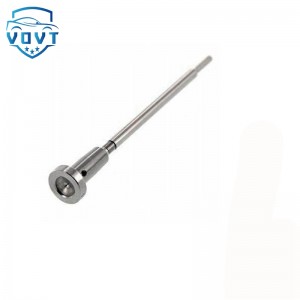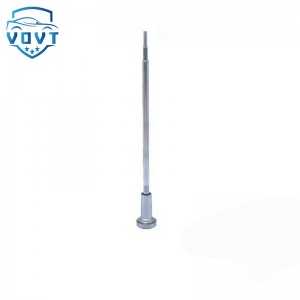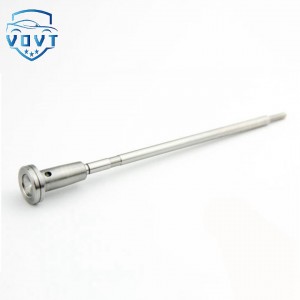High Precision New Diesel Injector Control Valve F00VC01372 Valve Assembly for Fuel Injector Engine Spare Parts
Products Description
| Reference Codes | F00VC01372 |
| Application | / |
| MOQ | 6 PCS |
| Certification | ISO9001 |
| Place of Origin | China |
| Packaging | Neutral packing |
| Quality Control | 100% tested before shipment |
| Lead time | 7~10 working days |
| Payment | T/T, L/C, Paypal, Western Union, MoneyGram or as your requirement |
What are the common faults of injector valve assemblies?
Abnormal injection faults
1. Uneven/abnormal injection amount
Cause:
Aging, short circuit or poor contact of the solenoid valve coil causes the valve core to delay or get stuck, and the injection amount cannot be accurately controlled.
Wear of the needle valve and the valve seat (such as impurities in diesel), the gap between the sealing surface becomes larger, and fuel leakage leads to a reduction in injection amount.
The oil circuit of the pressure control chamber is blocked (such as carbon deposits, metal debris), the hydraulic balance is unbalanced, and the injection pressure fluctuates.
Influence:
The engine idles and shakes, the acceleration is weak, and the uneven combustion of each cylinder leads to a decrease in power.
The air-fuel ratio is unbalanced, the fuel consumption is increased (the amount of fuel injection is large) or the emission exceeds the standard (the amount of fuel injection is small).
2. Injection timing error
Cause:
The solenoid valve responds to a delay (such as unstable power supply voltage, coil resistance changes), resulting in early or delayed injection.
The camshaft drive mechanism is worn (mechanical injector), and the valve core opening timing is not synchronized with the crankshaft angle.
Impact:
Injection too early: diesel engines may experience knocking and increased combustion noise; gasoline engines may cause premature ignition and damage the piston.
Injection too late: the fuel is not fully burned, black smoke (diesel engine) is emitted from the exhaust pipe or the emission of pollutants (HC, CO) increases.
3. Poor injection atomization
Cause:
The spray hole is blocked (such as colloid, water crystallization or additive deposition in the fuel), and the aperture becomes smaller, resulting in poor dispersion of fuel injection.
The needle valve lift is insufficient (such as spring fatigue, valve core jamming), and the high-pressure fuel cannot be fully atomized.
Impact:
The fuel and air are not mixed sufficiently, the combustion efficiency is reduced, and the engine power is reduced.
Unburned fuel is deposited in the combustion chamber, forming carbon deposits, which aggravates the wear of piston rings and valves.
2. Seal failure type faults
1. Internal leakage
Cause:
The needle valve and valve seat sealing cone are worn and scratched (such as fuel containing particulate impurities), and high-pressure fuel leaks into the combustion chamber during the injection interval.
The piston seals (O-rings, seals) of the pressure control chamber are aged and damaged, resulting in the inability to maintain oil pressure.
Impact:
The injection pressure drops, the atomization effect deteriorates, and the engine is difficult to start (especially when the fuel is diluted during cold start).
The diesel engine may have "secondary injection" (the fuel continues to drip after the injection is completed), resulting in incomplete combustion and emission of black smoke.
2. External leakage
Cause:
The seal gasket between the injector and the cylinder head mounting surface is damaged (such as high temperature aging, extrusion deformation during installation).
The return oil pipe joint is loose or cracked, and the fuel leaks to the outside of the engine.
Impact:
Fuel waste may cause the risk of fire in the engine compartment.
The leaked fuel contaminates the engine components, affects the heat dissipation or causes electrical system failure.
Mechanical jamming failures
1. Valve core jamming (needle valve/solenoid valve armature)
Cause:
Poor fuel quality (containing water, colloid or metal particles), impurities are deposited in the gap between the valve core and the valve sleeve, causing jamming.
Fuel coking at high temperature (such as long-term high-load operation) forms carbon deposits on the valve core surface.
Mechanical wear (such as the clearance between the needle valve and the valve sleeve is too large or too small).
Impact:
The valve core cannot be opened or closed normally, resulting in injection interruption (stuck in the closed state) or continuous injection (stuck in the open state).
When stuck in the closed state, the corresponding cylinder does not work and the engine shakes; when stuck in the open state, it may cause the engine to overspeed or explode.
2. Spring failure
Cause:
The spring is affected by high-frequency vibration or high temperature for a long time, and its elasticity is weakened, broken or deformed.
Impact:
The needle valve closing force is insufficient, and the seal fails, resulting in fuel dripping.
After the injection is completed, the valve core reset is delayed, affecting the timing and pressure of the next injection.
Electrical failure (electronic fuel injector)
1. Solenoid valve failure
Cause:
The insulation layer of the coil is aged and punctured, resulting in a short circuit or open circuit (such as poor wiring harness contact, voltage fluctuations burning the coil).
There are impurities (such as iron filings) between the armature and the core, which increases the resistance of the solenoid valve and delays the response.
Impact:
The ECU cannot control the solenoid valve, the injector stops working, and the corresponding cylinder is turned off.
Fault code alarm (such as P0201-P0208, each cylinder injector circuit failure), the engine enters limp mode.
2. Line fault
Cause:
The injector harness is worn, broken or the plug is oxidized, resulting in interruption of signal transmission.
Impact:
The ECU cannot receive the injector feedback signal, cannot accurately control the injection amount and timing, and the engine performance is reduced.
Other common faults
1. Carbon deposits and coking
Cause:
The high sulfur content of the fuel and the abnormal combustion temperature lead to carbon deposits on the injector head (especially in the gasoline engine direct injection system).
Long-term low-load operation, poor fuel atomization, and unburned fuel deposits and cokes at the spray hole.
Impact:
The spray hole is blocked, the injection angle is offset, and the fuel cannot be accurately sprayed into the combustion chamber.
Carbon deposits cause the needle valve to get stuck and the seal to fail.
2. Abnormal pressure
Cause:
The common rail system (diesel engine) pressure sensor is faulty, resulting in unstable input pressure of the injector valve assembly.
The pressure accumulator is worn and leaking, and the high pressure required for injection cannot be maintained.
Effect:
When the high pressure is insufficient, the atomization is poor and the combustion is incomplete; when the high pressure is too high, the seal may be damaged or abnormal injection may occur.























